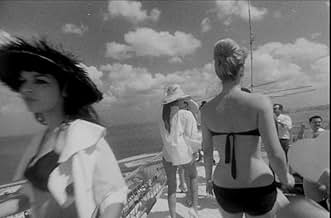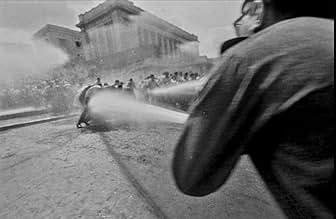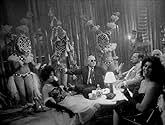Soy Cuba
- 1964
- Tous publics
- 2h 21min
NOTE IMDb
8,2/10
12 k
MA NOTE
Quatre vignettes sur la vie du peuple cubain pendant l'époque pré-révolutionnaire.Quatre vignettes sur la vie du peuple cubain pendant l'époque pré-révolutionnaire.Quatre vignettes sur la vie du peuple cubain pendant l'époque pré-révolutionnaire.
- Réalisation
- Scénario
- Casting principal
- Récompenses
- 2 victoires et 1 nomination au total
Mario González Broche
- Pablo
- (as Mario González)
Avis à la une
Is this the best film ever made? For me today in its afterglow it is.
I'm so fickle. I think if all else were equal, I'll always take embodied, real cinema that is coherently integrated. The way of telling the story is ideally complex and folded, using tricks to make the story matter. But if the storytelling is less spectacular, as long as the thing engages, that's what matters. If it changes me, its art and important, regardless of whether I can tell a good story about the storytelling.
That's the way I prefer. But sometimes the storytelling is so spectacular, so engaging in itself, that it doesn't matter what the story is. These are rare, because after all, you need the touch to change your life. So a filmmaker as unsophisticated and unattractive as, say Elia Kazan, can modify my existence when partnered with Williams and Brando.
And this story... what is conveyed here is mostly lies. Or rather it is a target story that is transparently bankrupt. Its based on an embodied reality of sorts. But its a twisted vision. The racism is palpable. The superiority of the European eye and mind are overwhelming. The simple notion of good and evil is less nuanced than in Star Wars or its predecendent westerns, and is intolerable. (This may be simply because history advises that both the Soviet and Cuban experiments were more brutal than what they replaced.)
But what cinema! What life! Just inhabiting this world has adjusted my imagination and dreams. The focus is usually on the extraordinary flying camera, because its so obvious, striking. It is, and if it were just that, I would still get you out of bed and across town to see this. But the flying eye is integrated with an architectural expression that is far deeper. The actors and camera move through buildings, fire, smoke, cane, trees, exploding dirt. This is as amazing the first time, just in wondering how they did it. Knowing the technology used, it seems impossible, and that knowledge actually distracts. You have to see this several times to just get past the wonder at the talking dog.
Then you can get into the visual poetry of thing. It isn't about people at all. They matter not at all except as fodder for ennobling posters. What matters is the structure of the forces that surround and channel them here and there like turbulent banks. This is a project centered on those forces, incarnated as spatial forces. Where in another project you wonder how a dog can be so dramatic, here you wonder how the director was able to control fire and smoke to be so perfectly compliant. Its not embodied in the story, which is daft, but in the real world that contains it.
This is absolutely in the spirit of Tarkovsky, and is the only film I know that betters him visually. Its less human, but oh so spatial. You must, must see it.
Ted's Evaluation -- 4 of 3: Every cineliterate person should experience this.
I'm so fickle. I think if all else were equal, I'll always take embodied, real cinema that is coherently integrated. The way of telling the story is ideally complex and folded, using tricks to make the story matter. But if the storytelling is less spectacular, as long as the thing engages, that's what matters. If it changes me, its art and important, regardless of whether I can tell a good story about the storytelling.
That's the way I prefer. But sometimes the storytelling is so spectacular, so engaging in itself, that it doesn't matter what the story is. These are rare, because after all, you need the touch to change your life. So a filmmaker as unsophisticated and unattractive as, say Elia Kazan, can modify my existence when partnered with Williams and Brando.
And this story... what is conveyed here is mostly lies. Or rather it is a target story that is transparently bankrupt. Its based on an embodied reality of sorts. But its a twisted vision. The racism is palpable. The superiority of the European eye and mind are overwhelming. The simple notion of good and evil is less nuanced than in Star Wars or its predecendent westerns, and is intolerable. (This may be simply because history advises that both the Soviet and Cuban experiments were more brutal than what they replaced.)
But what cinema! What life! Just inhabiting this world has adjusted my imagination and dreams. The focus is usually on the extraordinary flying camera, because its so obvious, striking. It is, and if it were just that, I would still get you out of bed and across town to see this. But the flying eye is integrated with an architectural expression that is far deeper. The actors and camera move through buildings, fire, smoke, cane, trees, exploding dirt. This is as amazing the first time, just in wondering how they did it. Knowing the technology used, it seems impossible, and that knowledge actually distracts. You have to see this several times to just get past the wonder at the talking dog.
Then you can get into the visual poetry of thing. It isn't about people at all. They matter not at all except as fodder for ennobling posters. What matters is the structure of the forces that surround and channel them here and there like turbulent banks. This is a project centered on those forces, incarnated as spatial forces. Where in another project you wonder how a dog can be so dramatic, here you wonder how the director was able to control fire and smoke to be so perfectly compliant. Its not embodied in the story, which is daft, but in the real world that contains it.
This is absolutely in the spirit of Tarkovsky, and is the only film I know that betters him visually. Its less human, but oh so spatial. You must, must see it.
Ted's Evaluation -- 4 of 3: Every cineliterate person should experience this.
"Don't avert your eyes. Look! I am Cuba. For you, I am the casino, the bar, hotels and brothels. But the hands of these children and old people are also me" -- Yevgeni Yevtushenko
I Am Cuba is described by film critic Elliot Wilhelm as "a unique, insane, exhilarating spectacle". Filmed in Spanish, dubbed in Russian, and subtitled in English, this unique collaboration between Russian director Mikhail Kalatozov (The Cranes are Flying), the poet Yevgeni Yevtushenko, and writer Enrique Pineda Barnet dramatizes the conditions that led to the 1959 Cuban revolution. Originally made in 1964 (and unpopular both in Russia and Cuba), it was released in 1995 through the combined efforts of Martin Scorsese and Francis Ford Coppola.
I Am Cuba is set in the late 1950s when a ragtag bunch of students, workers, and peasants organized to overthrow the corrupt regime of dictator Fulgencio Batista. The film is divided into four sequences. The first depicts the American-run gambling casinos and prostitution in Havana. The next shows a farmer burning his sugar cane when he learns he is going to lose his land to United Fruit. Another describes the suppression of students and dissenters at Havana University, and the final sequence shows how government bombing of mountain fields induced farmers to join with the rebels in the Sierra Maestre mountains. The final scene is a triumphal march into Havana to proclaim the revolution.
Marvelously photographed in black and white by Sergei Urusevsky and using acrobatic camerawork by Alexandr Kalzaty, some of the shots and distorted camera angles are so staggering as to be virtually unbelievable. In one sequence, the camera lifts off from a hotel rooftop, takes in the Havana skyline, descends several floors, winds its way through the poolside party-goers, and then takes you for a swim in the pool in one continuous shot. Reminiscent of Sergei Eisenstein, the caricatures are broad but are presented with such exuberance that it hardly seems to matter. Audacious and imaginative, I Am Cuba is a revelation, not only for its style but also for its inspiration. Filmed with true visionary poetry, I Am Cuba transcends the genre of advocacy filmmaking to reach a pinnacle of cinematic art.
I Am Cuba is described by film critic Elliot Wilhelm as "a unique, insane, exhilarating spectacle". Filmed in Spanish, dubbed in Russian, and subtitled in English, this unique collaboration between Russian director Mikhail Kalatozov (The Cranes are Flying), the poet Yevgeni Yevtushenko, and writer Enrique Pineda Barnet dramatizes the conditions that led to the 1959 Cuban revolution. Originally made in 1964 (and unpopular both in Russia and Cuba), it was released in 1995 through the combined efforts of Martin Scorsese and Francis Ford Coppola.
I Am Cuba is set in the late 1950s when a ragtag bunch of students, workers, and peasants organized to overthrow the corrupt regime of dictator Fulgencio Batista. The film is divided into four sequences. The first depicts the American-run gambling casinos and prostitution in Havana. The next shows a farmer burning his sugar cane when he learns he is going to lose his land to United Fruit. Another describes the suppression of students and dissenters at Havana University, and the final sequence shows how government bombing of mountain fields induced farmers to join with the rebels in the Sierra Maestre mountains. The final scene is a triumphal march into Havana to proclaim the revolution.
Marvelously photographed in black and white by Sergei Urusevsky and using acrobatic camerawork by Alexandr Kalzaty, some of the shots and distorted camera angles are so staggering as to be virtually unbelievable. In one sequence, the camera lifts off from a hotel rooftop, takes in the Havana skyline, descends several floors, winds its way through the poolside party-goers, and then takes you for a swim in the pool in one continuous shot. Reminiscent of Sergei Eisenstein, the caricatures are broad but are presented with such exuberance that it hardly seems to matter. Audacious and imaginative, I Am Cuba is a revelation, not only for its style but also for its inspiration. Filmed with true visionary poetry, I Am Cuba transcends the genre of advocacy filmmaking to reach a pinnacle of cinematic art.
That I've ever seen, and I watch a lot of movies. The story is propaganda, to be sure, and some of the acting is horrible, but WOW! I couldn't take my eyes off of it. Shot after stunning shot....I don't know how they did it, but I didn't mind all the rhetoric because I kept thinking, "Look, that's so beautiful" and "Wow, how did they do that?" I do recommend it also as a historical document of a time most people don't remember....I was born the year it was made and remember "the Communist Threat" but I think a lot of people younger than myself may not remember.
Not to mention that yes, some of the music was also amazing. A must see for any serious film buff.
Not to mention that yes, some of the music was also amazing. A must see for any serious film buff.
Just about every comment posted here eulogises Soy Cuba's camera-work, which is certainly understandable as it is remarkably filmed, but this is done to the neglect of other extremely important aspects. Whether they are bigger fans of the camera-work or of the direction, however, all the commentators on these pages seem to share the caveat that arguably the main point of the film - its plot - amounts to nothing more than "silly propaganda" or a curiosity of totalitarian film making. Such an attitude is a terrible oversight! Soy Cuba is about people's desire for freedom and a better life, and the revolutionary potential of this desire when conditions reach a point beyond which people will no longer endure. It is about self respect, and courage, will and humanity and a human, filial patriotism; it is about the distillation of Cuba as an idea and a cause for justice and empowerment. I cannot understand how deeply postmodern and jaded, or just plain superficial, someone has to be to notice all the nuances of angle and light and completely miss the deep emotional and spiriual poetry of the content (in fact, the US government certainly paid good attention, for it banned the film until 1992)! It is like discussing Korda's portrait of Che Guevara in terms of focus and aperture alone!Did they not feel goosebumps as they watched the scene of the students on the steps, and the dead dove? I am lost for words! Indeed, if it were just a vapid propaganda piece, what explains its de facto censorship in the Soviet Union? I am quite sure that many of these commentators must have visited the Caribbean on holiday at one time or another; I know from my own experiences, and they ought to have immediately realised on seeing the film, that the portrait the it paints of Cuba remains the reality of Jamaica, Dominican Republic, Haiti today, some 65 years later. Watching this film, we should above all feel indignant, rather than heaping praise onto disembodied and decontextualised technicalities such as camera-work. To dismiss it as propaganda yet ogle at its images is akin to prostituting this beautiful, very deeply moving, and inspiring film, the same way that Cuba herself was prostituted. Shame on you.
No less than thirty shots have been ripped off from this movie in the past five years, in films like Out of Sight, Boogie Nights, and Pulp Fiction. Watching "I Am Cuba" is an education in film technique and the beauty of the eponymous country. The picture's plot is abysmal. It is an exercise in cinematography. It is among the most influential movies, style-wise, that the American public has never seen and honestly brilliant on all terms.
Imagine taking a tour of Cuba, in 1964, through the eyes of four metaphors: luxury, poverty, revolution, and vagrancy. Times are changing, the country is changing. However, no matter how much anything changes, the sun-soaked gorgeousness of the land doesn't budge. The camera glides around like a member of the tour who has gone off on his own, looking at the four principles.
I Am Cuba is film that needs no hyperbole. It Is Great
Imagine taking a tour of Cuba, in 1964, through the eyes of four metaphors: luxury, poverty, revolution, and vagrancy. Times are changing, the country is changing. However, no matter how much anything changes, the sun-soaked gorgeousness of the land doesn't budge. The camera glides around like a member of the tour who has gone off on his own, looking at the four principles.
I Am Cuba is film that needs no hyperbole. It Is Great
Le saviez-vous
- AnecdotesThe now famous long take that begins at the top of the hotel, then winds around and down into the swimming pool, originally come out of the water and continued. The camera was hand held, passed from crew member to crew member, to make its way down the side of the hotel into the pool. The camera lens had been equipped with a high speed, spinning glass disk taken from a submarine periscope. The spinning disk was installed to fling water drops off of the lens when the camera emerged from the swimming pool at the end of the shot. Much to the disappointment of the camera crew, director Mikhail Kalatozov cut the end of the take, ending it underwater.
- GaffesWhen Enrique gets to the top of the high-rise building he gains access to the roof by stepping through a window with a broken pane of glass. When he returns, the pane in same window is unbroken.
- ConnexionsFeatured in Soy Cuba, O Mamute Siberiano (2004)
- Bandes originalesLoco amor
(Spanish-speaking adaptation of the 1958 song "Crazy Love")
Music and lyrics by Paul Anka
Performed by El Duo Los Diablos (as Los Diablos Demonicos)
Added accompaniment music recorded later at the Prado 210 studio
With Chucho Valdés (piano), Guillermo Barreto (drums) and Orlando "Cachaito" Lopez (bass).
Meilleurs choix
Connectez-vous pour évaluer et suivre la liste de favoris afin de recevoir des recommandations personnalisées
- How long is I Am Cuba?Alimenté par Alexa
Détails
- Date de sortie
- Pays d’origine
- Site officiel
- Langues
- Aussi connu sous le nom de
- Je suis Cuba
- Lieux de tournage
- Calle M & 23 Ave, La Havane, Cuba(rooftop scene: Enrique as a sniper)
- Sociétés de production
- Voir plus de crédits d'entreprise sur IMDbPro
Box-office
- Montant brut aux États-Unis et au Canada
- 168 100 $US
- Montant brut mondial
- 274 098 $US
- Durée2 heures 21 minutes
- Couleur
- Mixage
- Rapport de forme
- 1.37 : 1
Contribuer à cette page
Suggérer une modification ou ajouter du contenu manquant
























